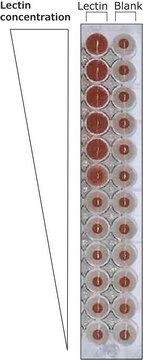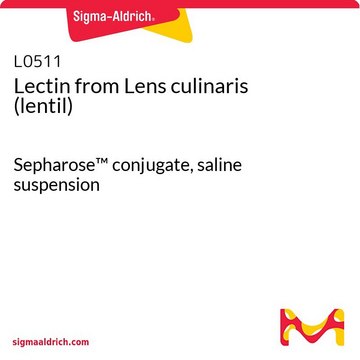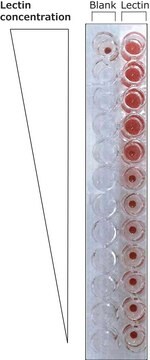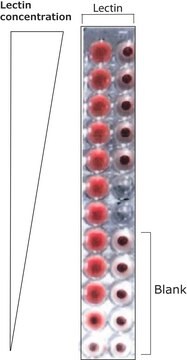L0401
Lectin from Lycopersicon esculentum (tomato)
FITC conjugate, buffered aqueous solution
Sinonimo/i:
Lycopersicon esculentum agglutinin, LEA
Autenticatiper visualizzare i prezzi riservati alla tua organizzazione & contrattuali
About This Item
Codice UNSPSC:
12352202
NACRES:
NA.32
Prodotti consigliati
Coniugato
FITC conjugate
Livello qualitativo
Stato
buffered aqueous solution
Grado di funzionalizzazione
2.0-6.0 mol FITC per mol lectin
Temperatura di conservazione
2-8°C
Cerchi prodotti simili? Visita Guida al confronto tra prodotti
Descrizione generale
Lectins are carbohydrate binding proteins. Lectin from Lycopersicon esculentum (LEA) binds strongly to polylactosamine oligosaccharides. It is the major component of endothelial and epithelial cell surface carbohydrate.
Applicazioni
Lectin from Lycopersicon esculentum (tomato) has been used:
- for immunofluorescence staining
- for the quantification of vascular perfusion
- for the evaluation of gel perfusion efficiency
Azioni biochim/fisiol
LEA is not blood group specific, but has an affinity for N-acetyl-β-D-glucosamine oligomers. The lectin is a glycoprotein containing approx. equal amounts of protein and carbohydrate and is reported to inhibit the mitogenic activity of phytohemagglutinin from Phaseolus vulgaris. This lectin binds endothelial cells and is used to visualize the microvasculature.
Lectin has anti-cancer, anti-human immunodeficiency virus (anti-HIV), anti-microbial infection and blocks mucosal atrophy. It reduces type 2 diabetes and obesity, stimulates nutrient absorption and drug targeting. It is used to stain the vascular tree in the spinal cord and brain of animals. Lectin agglutinates cells and precipitates polysaccharides and glycoproteins.
Confezionamento
Sold on the basis of mg active conjugate.
Stato fisico
Solution in 10 mM HEPES, 0.15 M NaCl, pH 7.5, containing 0.1 mM Ca2+, 0.08% sodium azide and 5 mg/mL β-cyclodextrin.
Risultati analitici
Agglutination activity is expressed in μg/ml and is determined from serial dilutions in phosphate buffered saline, pH 7.3, of a 1 mg/ml solution. This activity is the lowest concentration to agglutinate a 2% suspension of human erythrocytes after 1 hour incubation at 25 °C.
Codice della classe di stoccaggio
12 - Non Combustible Liquids
Classe di pericolosità dell'acqua (WGK)
WGK 2
Punto d’infiammabilità (°F)
Not applicable
Punto d’infiammabilità (°C)
Not applicable
Scegli una delle versioni più recenti:
Possiedi già questo prodotto?
I documenti relativi ai prodotti acquistati recentemente sono disponibili nell’Archivio dei documenti.
I clienti hanno visto anche
Melatonin suppresses toll like receptor 4-dependent caspase-3 signaling activation coupled with reduced production of proinflammatory mediators in hypoxic microglia
Yao L, et al.
PLoS ONE, 11(11), e0166010-e0166010 (2016)
Lycopersicon esculentum lectin: an effective and versatile endothelial marker of normal and tumoral blood vessels in the central nervous system
Mazzetti S, et al.
European Journal of Histochemistry, 48(4), 423-428 (2009)
Lectin conjugates as biospecific contrast agents for MRI. Coupling of Lycopersicon esculentum agglutinin to linear water-soluble DTPA-loaded oligomers
Pashkunova-Martic I, et al.
Molecular Imaging and Biology : MIB : The Official Publication of the Academy of Molecular Imaging, 13(3), 432-442 (2011)
Loss of serglycin promotes primary tumor growth and vessel functionality in the RIP1-Tag2 mouse model for spontaneous insulinoma formation
Hamilton A, et al.
PLoS ONE, 10(5), e0126688-e0126688 (2015)
Alba Grayston et al.
Journal of cerebral blood flow and metabolism : official journal of the International Society of Cerebral Blood Flow and Metabolism, 42(2), 237-252 (2021-07-08)
The increasing use of mechanical thrombectomy in stroke management has opened the window to local intraarterial brain delivery of therapeutic agents. In this context, the use of nanomedicine could further improve the delivery of new treatments for specific brain targeting
Il team dei nostri ricercatori vanta grande esperienza in tutte le aree della ricerca quali Life Science, scienza dei materiali, sintesi chimica, cromatografia, discipline analitiche, ecc..
Contatta l'Assistenza Tecnica.









